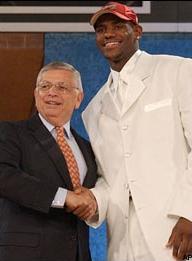 Chris Graham of the Augusta Free Press has an in-depth look at the new age restriction for the NBA draft, which requires that a player be at least 19 years-old on December 31 of the year of the NBA Draft and that at least one NBA season must have passed from when he graduated from high school, or when he would have graduated from high school, and the NBA Draft. He interviews Paul Haagen, Rick Karcher, and me, and we discuss the rationales behind the new rule. Rick outlines the NBA's business arguments for pursuing it, while Paul and I question the logic behind it, especially considering the empirical data on players who have pursued the NBA out of high school (i.e., they are small, self-selected group who has averaged more points, rebounds, and assists than the average NBA player or the average player of any age group, and that includes high school players who failed to make the NBA and who were counted as "0" in the empirical analysis).
Chris Graham of the Augusta Free Press has an in-depth look at the new age restriction for the NBA draft, which requires that a player be at least 19 years-old on December 31 of the year of the NBA Draft and that at least one NBA season must have passed from when he graduated from high school, or when he would have graduated from high school, and the NBA Draft. He interviews Paul Haagen, Rick Karcher, and me, and we discuss the rationales behind the new rule. Rick outlines the NBA's business arguments for pursuing it, while Paul and I question the logic behind it, especially considering the empirical data on players who have pursued the NBA out of high school (i.e., they are small, self-selected group who has averaged more points, rebounds, and assists than the average NBA player or the average player of any age group, and that includes high school players who failed to make the NBA and who were counted as "0" in the empirical analysis).
We then discuss different reasons for why it may be difficult for a player to challenge it in court.
Rick describes how the rule only affects players outside of the bargaining unit, and thus why existing players don't have a clear incentive to fight it:
The way I look at this now - from a bargaining standpoint, the union doesn't have an incentive to vigorously fight the owners on this issue. It doesn't affect existing players at all. You're talking about a rule that affects prospective players. Existing players are not affected by it. So the union in the bargaining process isn't giving up much when they agree to this - and in return the existing players are getting something of value in the form of an increased percentage of league revenue from the owners.I reflect upon my experience as having been one of Maurice Clarett's lawyers in Clarett v. NFL, and discuss the practical difficulties of being a plaintiff in an age-eligibility case:
I think one of the difficulties for a player to sue is that they'll automatically be labeled a troublemaker, somebody who's trying to break the system, a maverick. It's going to take a lot for a 17- or 18-year-old to be a plaintiff in a litigation where much of the media and most of the fans will be immediately against him - putting a lot of pressure on him and his family. We saw that with Maurice Clarett - he immediately became vilified when he brought the lawsuit. Anybody who tries to challenge the system is deemed as a troublemaker. We've seen that in other contexts of the law.With that analysis in mind, I found a story by Eli Saslow in today's Washington Post very interesting. Entitled, "Is There Such a Thing as a Perfect 10?," Saslow discusses 10-year old
 Justin Jenifer, a 4-6 point guard from Maryland who is considered by some to be the best basketball player aged 10 and under. The article details how Justin is "pursued by Amateur Athletic Union summer league teams that troll nationally for players, high school coaches who recruit aggressively and shoe companies whose scramble for potential future endorsers continues for a second decade." It also describes how Justin's life seems completely invested in basketball.
Justin Jenifer, a 4-6 point guard from Maryland who is considered by some to be the best basketball player aged 10 and under. The article details how Justin is "pursued by Amateur Athletic Union summer league teams that troll nationally for players, high school coaches who recruit aggressively and shoe companies whose scramble for potential future endorsers continues for a second decade." It also describes how Justin's life seems completely invested in basketball.By implication, Saslow's article suggests that a higher age floor for the NBA will likely have no effect on the Hoop Dreams culture of youth basketball. There will still be the shoe companies jockeying for influence, the coaches and scouts from amateur leagues, high schools, and colleges trolling the sidelines, and the omnipresent parents obsessed with making their kids stars. And perhaps instead of 18-year old NBA players, maybe we should be more worried about things like this:
Across the gym, Scottie Bowden pulled down a flat-brimmed Washington Nationals hat until it almost shielded his eyes. A representative of Adidas, Bowden had invested many weekends and about $20,000 of company money in Justin and his teams. Bowden had provided the boy and his teammates with sneakers and travel money to tournaments in an effort to build brand loyalty in a 10-year-old with distant NBA prospects. In Justin, had Bowden accurately identified a star?





0 comments:
Post a Comment